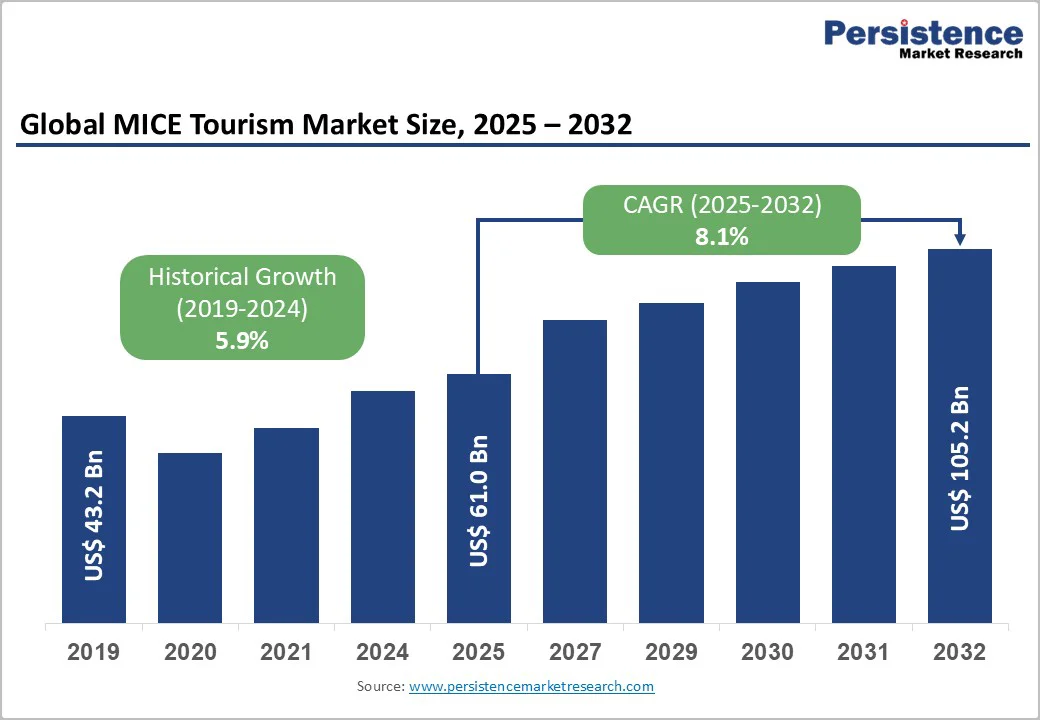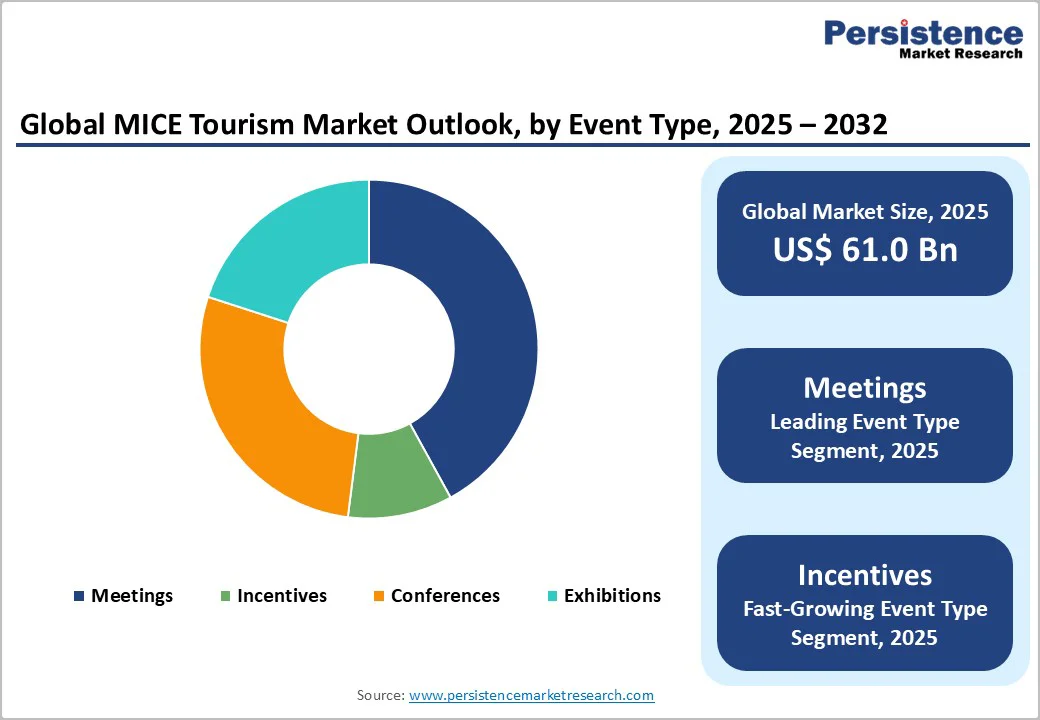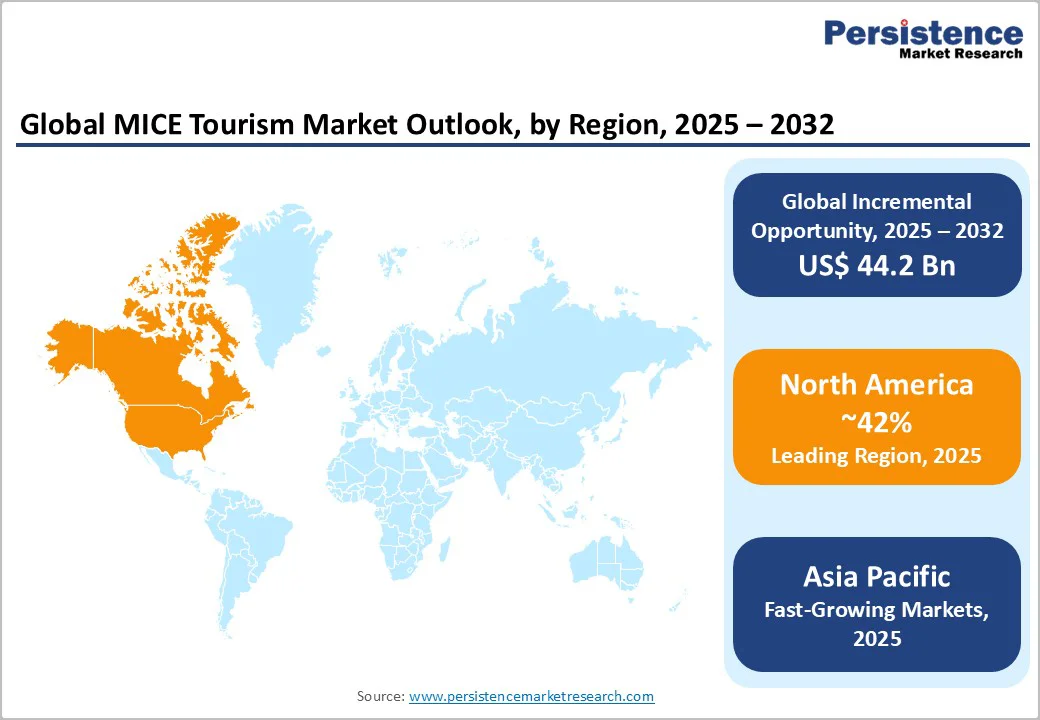ID: PMRREP34149| 199 Pages | 3 Dec 2025 | Format: PDF, Excel, PPT* | Consumer Goods

The global MICE tourism market size is likely to be valued at US$61.0 billion in 2025 and projected to reach US$105.2 billion, growing at a CAGR of 8.1% between 2025 and 2032.
This substantial expansion reflects the structural transformation within the business events ecosystem, characterized by a resurgence in face-to-face gatherings coupled with hybrid and digital innovations.
Robust demand for corporate meetings, business networking, professional knowledge exchange, and large-scale exhibitions continues to drive growth in the sector, supported by improved economic conditions, renewed confidence in business travel, and strategic infrastructure investments across multiple geographies.
| Key Insights | Details |
|---|---|
| MICE Tourism Market Size (2025E) | US$61.0 billion |
| Market Value Forecast (2032F) | US$105.2 billion |
| Projected Growth CAGR (2025 - 2032) | 8.1% |
| Historical Market Growth (2019 - 2024) | 5.9% |

Corporate business travel is experiencing a decisive rebound, with travel budgets in major economies surpassing pre-pandemic levels and business travelers showing strong intent to resume frequent in-person participation at conferences, exhibitions, and incentive events by 2025.
This revival is driven by the proven commercial value of face-to-face engagement: 64% of global decision-makers report higher revenue when travel increases, and every dollar invested in corporate travel generates up to 12 dollars in new business opportunities.
The resurgence is further supported by rapid digitalization in event management, including AI-driven attendee analytics, automated registrations, and hybrid engagement tools that optimize experience quality and ROI.
Small and mid-sized businesses are increasingly joining large enterprises in expanding travel activity. At the same time, high-engagement sectors such as pharmaceuticals, information technology, financial services, and consulting remain consistent growth anchors for global MICE demand.
Governments worldwide are accelerating the expansion of the MICE industry by strengthening policy frameworks, incentivizing infrastructure development, and reducing administrative barriers for business travelers.
India’s national MICE strategy outlines the creation of multiple city-level convention bureaus to attract large-scale international events. It targets a significant increase in bureau-led inbound meetings within five years. In the Middle East, Saudi Arabia’s Vision 2030 aims to elevate the sector’s GDP contribution to 8.8%, supported by large-scale investments in convention districts across Riyadh, Jeddah, and the Red Sea corridor.
The UAE continues to record nearly 9% annual MICE growth, reflecting strong institutional backing. North America is also expanding capacity, highlighted by Dallas’s US$3.7-billion convention center development and major airport upgrades. Public–private partnerships across destinations are strengthening supply chains, improving service quality, and enabling globally competitive event-hosting ecosystems.
Growing expectations for sustainable event operations are significantly increasing the cost and complexity of MICE planning. Organizers must now comply with evolving ESG frameworks, carbon accounting standards, and stricter reporting mandates imposed by corporations and regulators.
This requires sourcing eco-certified venues, adopting low-waste and circular-event models, and integrating renewable energy or efficient resource-use systems, each of which adds planning layers and procurement challenges. Additionally, clients in Europe, the U.S., and advanced Asian markets are more price-sensitive yet demand higher sustainability transparency, prolonging decision cycles.
These rising compliance pressures and operational requirements elevate baseline expenses and introduce new logistical hurdles for organizers.
Security-related uncertainties are becoming a major restraint for MICE events, as organizers must navigate risks ranging from cyberattacks and data leaks to physical safety threats. International events face layers of regulatory scrutiny, including GDPR, data-localization rules, and sector-specific compliance, all of which complicate technology integration and attendee management.
Meanwhile, geopolitical instability-whether conflicts, sanctions, visa restrictions, or sudden travel advisories-can disrupt event timelines, supply chains, and delegate participation with little warning. As a result, organizers face higher insurance premiums, expanded vetting processes, and stringent safety protocols, requiring specialized vendors and increasing overall operational costs for global MICE planning.
Hybrid and technology-enabled event formats are emerging as one of the strongest growth opportunities in the global MICE industry, driven by rising demand for flexibility, reach, and continuous community engagement.
The popularity of hybrid models grew by 20% in 2024, with more than three-quarters of event planners reporting higher client interest. These formats enable organizers to expand audiences across borders by combining physical interaction with virtual scalability.
Advanced analytics and AI-powered platforms-such as Bizzabo’s automated engagement engine-help reduce attendee drop-offs, personalize recommendations, and elevate session relevance.
Tools like Gevme’s Snapsight enhance participation through real-time insights and post-event intelligence, while blockchain-based ticketing and immersive 3D virtual environments are reshaping monetization models and attendee experience design. Together, these technologies open new revenue streams and create resilient, year-round engagement ecosystems.
Wellness, leisure, and experiential enrichment are becoming foundational opportunities for MICE destinations and service providers. With 67% of bleisure trips originating from conferences and meetings, organizers increasingly package events with leisure extensions to attract higher delegate participation.
The U.S. leads this momentum, accounting for 88% of all domestic bleisure trips, prompting airlines and hospitality brands to tailor bundles with flexible fares, fitness benefits, and wellness upgrades. Hotels, resorts, and DMCs are forming deeper partnerships to curate customized experiences-mindfulness programs, outdoor activities, local culture immersions, and culinary tours-that extend traveler stays and increase per-capita spending.
These experiential layers not only boost attendee satisfaction and engagement metrics but also strengthen destination competitiveness, offering high-margin upsell opportunities for the entire MICE value chain.
Meetings continue to dominate the global MICE structure with an estimated 42% share in 2025, reflecting their critical role as the backbone of corporate communication and strategic alignment. These include board reviews, annual business planning, sales summits, training programs, and product or partner launches across major sectors.
The format delivers strong commercial value due to its repeatable nature and the growing integration of digital scheduling, automated registration, and enhanced AV infrastructure. Venue selection for meetings is strongly influenced by capacity, cost, location, and service quality, ensuring consistent year-round demand.
Healthcare and pharmaceuticals remain among the strongest industry contributors to MICE activity, supported by consistent international demand for medical congresses, clinical trial discussions, regulatory compliance workshops, and continuing medical education programs. These events typically attract global delegates due to rapid advancements in biotechnology, diagnostics, and medical devices.
While the sector is estimated to hold around 15% market share with strong multi-year growth projections, its stability is reinforced by a high need for scientific exchange and regulatory coordination. Asia and Europe continue to act as major hubs for innovation-driven medical gatherings.
Meanwhile, emerging fields including fintech, cybersecurity, clean energy, and climate-tech also sustain robust multi-sector MICE spending through recurring conferences and multi-stakeholder summits.
Large events with more than 100 attendees are projected to capture around 64% of the global MICE market in 2025 due to their ability to maximize networking scale, deliver multi-track sessions, and generate significant exhibitor and sponsorship value. These events rely heavily on premium hotels, convention centers, and city-scale event districts, where infrastructure, logistics, and high-tier services support complex program formats.
Large gatherings also attract higher spending per delegate across accommodation, F&B, and local transport. In contrast, smaller events play an increasingly strategic role by supporting focused workshops, innovation labs, leadership retreats, and cost-sensitive corporate engagements, often coupled with hybrid digital add-ons for extended reach.
Premium 5-star and luxury hotels account for an estimated 32% of major MICE events, offering integrated accommodation, high-quality AV systems, professional event staff, and central city accessibility. Their appeal is especially strong in gateway business destinations such as Singapore, Dubai, London, Delhi, New York, and Tokyo.
Convention centers, however, retain the largest share at approximately 46%, driven by their capacity to host mega-exhibitions, trade fairs, and multi-day international congresses. They provide specialized infrastructure, modular halls, and exhibitor-ready facilities.
Nontraditional venues-including cruise liners, cultural venues, and experiential outdoor sites-are recording double-digit growth as organizers seek unique formats. Corporations increasingly use their own innovation campuses, while universities host high-volume academic and association meetings.

North America remains one of the world’s most influential MICE regions, anchored by the United States’ extensive convention infrastructure, high international connectivity, and strong corporate travel spending.
Major cities such as Las Vegas, Orlando, Chicago, New York, and Dallas consistently rank among global leaders in convention capacity and delegate volume, supported by world-class venues and robust hotel pipelines. STR and JLL report continued pressure on room supply, with hotel rate inflation driven by sustained event demand and slow new-build growth.
Canada’s Toronto, Montreal, and Vancouver, along with Mexico City and Cancun, strengthen regional cross-border MICE flows through policy incentives and upgraded venues. North America is also a frontrunner in event-technology adoption, including AI-driven scheduling, analytics-based planning, and hybrid-ready delivery models.
Key challenges include capacity constraints in peak months, inflation-linked operational costs, and rising sustainability expectations. Still, the region maintains a strong global influence through high-profile events in technology, medical sciences, and energy.
Europe remains a dominant force in the global MICE landscape, supported by its dense concentration of convention centers, seamless cross-border mobility, and a mature institutional ecosystem.
ICCA rankings consistently place Germany, the United Kingdom, France, Spain, and Italy among the world’s top meeting destinations, reflecting their advanced venue networks and strong association-event calendars. Europe’s integrated transport systems-particularly high-speed rail and extensive airport connectivity-enable efficient attendee movement across major hubs.
Europe is a global benchmark for sustainability, with ESG compliance, carbon reporting, and waste-management protocols increasingly embedded into venue operations and event standards. Leading facilities such as ExCeL London, Messe Frankfurt, and Paris Convention Centre showcase Europe’s capacity for large-scale, multi-track events.
SMEs and knowledge-driven sectors further stimulate regional MICE activity through innovation, education, and industry congresses. While competition is intense across destinations, Europe’s regulatory stability, skilled workforce, and long-standing event heritage reinforce its leadership in global business tourism.
Asia Pacific is the fastest-growing MICE region, supported by rapid economic expansion, strong government investment in convention infrastructure, and rising intra-regional business travel.
Countries such as China, Singapore, Japan, India, Thailand, and Australia continue to expand venue capacity and strengthen aviation networks, positioning the region as a hub for technology, pharmaceuticals, manufacturing, and financial conferences. Singapore and Bangkok consistently rank among ICCA’s top global meeting cities, reflecting their connectivity, safety, and event-friendly regulatory frameworks.
China’s major cities-Shanghai, Shenzhen, and Beijing-host some of the world’s largest trade fairs, supported by ongoing urban development and policy backing. India is accelerating its presence with new convention bureaus and facilities in Mumbai, Delhi, and Hyderabad.
Innovation is a defining feature, with widespread adoption of AI-driven venue management, immersive technologies, and wellness-led event design. Post-pandemic recovery in corporate travel further strengthens Asia Pacific’s momentum, making it a central growth engine for global MICE.

The global MICE industry remains highly fragmented, with multinational event-management firms, TMCs, DMCs, venue groups, and specialized exhibition organizers competing alongside rapidly expanding event-technology providers.
Leading players such as BCD Meetings & Events, CWT Meetings & Events, Maritz, FCM Meetings & Events, ATPI, and Questex differentiate through global delivery networks, compliance expertise, sector-specific capabilities, and long-standing enterprise relationships.
Technology has become the primary arena of competition, with providers integrating AI-driven matchmaking, real-time analytics, VR-based venue visualization, and hybrid-ready production tools into end-to-end service models. Consolidation is accelerating, particularly through acquisitions of spatial-design, virtual-event, and registration-platform specialists by larger ecosystem players.
Strategic partnerships between planners, hotel chains, and technology integrators strengthen sustainability, data governance, and operational efficiency. Regional firms in high-growth markets-especially the Middle East and Asia-are also scaling quickly, contributing to a more diversified and innovation-driven competitive environment.
The market stands at US$ 61.0 billion in 2025 and is projected to reach US$ 105.2 billion by 2032, reflecting an 8.1% CAGR and 72.5% overall growth.
Demand is driven by rebounding corporate travel, accelerated digitization and AI use, enhanced venue infrastructure, government incentives, hybrid event adoption, and rising wellness-oriented attendee expectations.
Meetings lead with a 42% share, supported by strong corporate reliance on in-person training, planning, launches, and relationship-building activities.
Europe leads the global market with around 50% share, while Asia Pacific remains the fastest-growing region.
Major opportunities lie in tech-driven hybrid events, expanding wellness and bleisure travel, and high-personalization digital engagement models.
Key players include BCD Meetings & Events, CWT, Maritz, ATPI, FCM, Questex, AVIAREPS AG, Cvent, Informa, Amex GBT, along with major hotel groups such as Marriott and Radisson, and regional players like Mach Conferences.
| Report Attribute | Details |
|---|---|
| Historical Data/Actuals | 2019 - 2024 |
| Forecast Period | 2025 - 2032 |
| Market Analysis Units | Value: US$ Mn/Bn, Volume: As Applicable |
| Geographical Coverage |
|
| Segmental Coverage |
|
| Competitive Analysis |
|
| Report Highlights |
|
By Event Type
By Industry Themes
By Event Size
By Venue Type
By Regions
Delivery Timelines
For more information on this report and its delivery timelines please get in touch with our sales team.
About Author